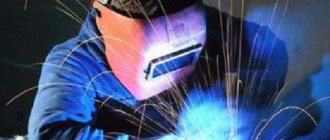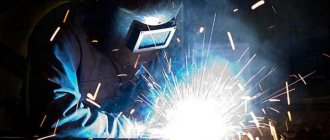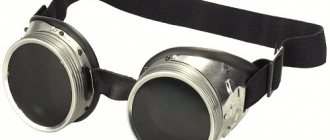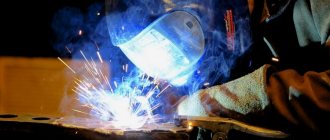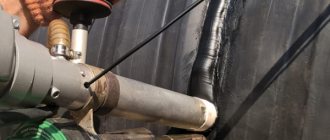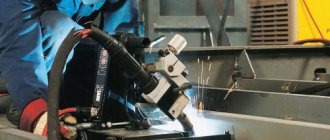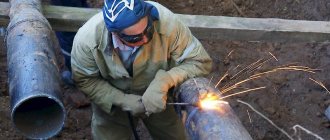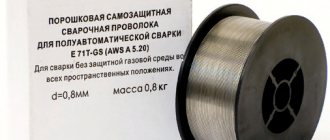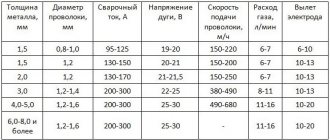According to research by the Ministry of Labor of the Russian Federation, the welding profession is among the top 50 most popular specialties in the country. This is justified, since welding work is present in many industries, from the construction industry to the oil and gas industry. The workers receive a good salary, but their work is not the easiest.
A welder is a working profession that involves performing tasks in a production environment.
When did it appear
Humanity mastered the first welding skills back in the 9th-10th centuries. BC. After forging, pieces of semi-precious and precious metals were placed in a special mold. After heating, the molten mass was poured onto the joints. This process is called foundry welding. Weapons and tools were made through furnace processing. To do this, iron blanks were heated in a forge with further forging of the joints.
Significant advances in electricity and physics occurred in the 18th and 19th centuries. After the invention of the voltaic column, the domestic scientist V.V. Petrov. discovered an electric arc formed between a pair of carbon electrodes. This phenomenon formed the basis of electric welding, since temperatures of about 5,000 °C can melt any metal.
In 1881 Benardos N.N. gave a description of welding with a carbon electrode. Subsequently, tungsten analogues, oxygen gas cutters, and burners appeared. With the development of technology, the specialty of a welder was divided into several categories with an assessment of the worker’s skill according to qualification classes.
How to become a welder
Like any other profession, to become a welder, you need to undergo a lot of training, which for the most part will consist of practice. First, they receive theoretical knowledge at a vocational school or college. If you come after 9th grade, you will have to study for at least three years, and after finishing 11 years, two is enough. To enroll, you do not need to take any special subjects. You can have a certificate with a minimum score and basic exams to easily get admitted. But you need to be prepared that you will still have to study mathematics, physics and chemistry. After completing training, the welder immediately receives the first rank, which will help him get a job and begin to gain experience and learn new things. Those who are especially successful in their studies may be given a second or third category in college.
The more varied tasks a welder performs, and the more skillful he becomes, the greater the chance of successfully passing the exam and then receiving a new rank. At the same time, you can receive higher education in a field related to welding in order to become a valuable employee and gain career growth.
Correct name and code of profession
The occupational code according to OKPDTR includes the code itself plus the index of the base group, control numbers indicating the rank, qualifications, type of remuneration, facets of conditions and the degree of mechanization of labor.
The welder profession code includes a code and control numbers.
For example, the profession code for electric and gas welder is 19756 2 02 7212 Х-Х-ХХ-Х-Х, where:
- the first 5 digits are the profession code;
- 2 – check digit;
- 02 – numbering according to ETKS;
- 7212 – OKZ group code;
- X – indicator according to the tariff schedule (from 1 to 8);
- X – qualification (from 1 to 3);
- XX – form of remuneration (from 10 to 22);
- X – normal/difficult/particularly difficult working conditions (1/2/3);
- X – mechanization of work (from 1 to 5).
Description of types of welders
Depending on the equipment used and the surfaces serviced (OKPDTR code in brackets), the profession in question may also be called:
- welder of reinforcement products (18329);
- welder of refractory metals (18333);
- welder using diffuse welding equipment (18334);
- HDTV welder (18340);
- thermite welder (18350).
We recommend reading: How to make a potbelly stove for your garage yourself
Depending on the equipment used, the profession may have different names.
There are separate categories: electric gas welder-tapper (19758), furnace pipe welder (18344), press welding operator (18338).
Place of work and career
In conditions of a general shortage of working personnel, the profession of a welder is of special importance: welding work is required in almost any production, and there are very few young craftsmen. That's why welders' salaries are high.
Welding work is used in many industries. Welders work on construction sites, creating structures and systems of various communications, in industry, where they apply their experience and skills in mechanical engineering, shipbuilding and in other areas, such as energy, oil refining, and agriculture. It is difficult to name a segment of production where the labor of a welder would not be used.
Where to study?
| Colleges and technical schools by specialty | Speciality | Admission based on 9 classes | Admission based on 11 classes | Cost per year (rubles) | ||
| Metal forming | 3 g 10 | |||||
Back forward
Attention! Slide previews are for informational purposes only and may not represent all the features of the presentation. If you are interested in this work, please download the full version.
Equipment
: computer, multimedia projector, handouts.
Event goals
:
- formation of an idea about the development of the welding process, about further prospects for the development of metal welding technology,
- development of students’ cognitive interest, logical thinking through systematization of facts, observation, cognitive activity, ability to draw conclusions, speech development,
- development of communication competencies.
Methods: explanatory and illustrative.
Forms: frontal, group.
Progress of the event
Introduction
- Greetings
- Motivation
Welder
He's wearing a blue overall and blue glasses, He's holding a blue lightning bolt in his hands. She is alive: agile, strong. Look how furiously she fights! Then she fell silent, became quiet, curled up into a ball, and the welder touched her with a wire, and lightning sprinkled the gold of the stars, as if the firebird had spread its tail!
(Slide No. 1-4)
Board design: sayings about welding, about the profession “Welder”, proverbs about metals. (Annex 1)
It is safe to say that welding today is one of the foundations of human development. The work of a welder is almost an art. An experienced craftsman, like a sculptor, creates products of complex shapes from metal: from a water supply system to restoring the geometry of a car body. (Cartoon about a welder)
And, of course, a logical question arises: When did welding appear? When did people learn to connect refractory materials together? Maybe 50-100 years ago? Or is this one of humanity's newest discoveries? Let's try to understand this issue and consider the history of the development of welding. (Slide No. 5-7)
Messages from students:
Message No. 1 The history of the “Welder” profession began with the discovery by Russian academician Vasily Petrov in 1802 of the effect of an electric arc that arose between two carbon rods when current passed through them. Thanks to the very high temperature of the arc, it became possible to melt metals. Welding was carried out with a direct current electric arc burning between a carbon electrode and the metal, using filler wire. This welding method N.N. Bernados called it “electrohephaestus” after the ancient Greek god of blacksmithing. In 1888, Russian engineer N.G. Slavyanov improved the method of manual arc welding, replacing the carbon electrode with a metal one.
Message No. 2 The method of permanently connecting parts has been known since ancient times. People red-hot the edges of metal rods and connected them into one whole with hammer blows. This welding method is still well known today under the name forge welding. It is believed that the word “welding” comes from the name of the Slavic god of blacksmithing, Svarog. In ancient Rus', ring-shaped jewelry was welded, they knew how to weld glass bracelets, and in the 16th century, guns were made by welding from individual rings forged from iron.
Message No. 3 The technological process of welding developed in the Middle Ages. An example of this is the huge Dol Ghryeth cannon, created in 1382. The cannon was a forged pipe that was reinforced with external metal hoops attached to it using forge welding. This method of making artillery pieces was used all over the world. The largest examples of such guns were made in the 16th century in India. The weight of the guns was more than 50 tons, and the total length was more than 9 meters.
Message No. 4 The method of producing solid metal structures by welding and soldering has come to us since ancient times. Proof of this is gold jewelry with tin soldering that was found during excavations in the Egyptian pyramids and lead water pipes with a transverse soldered seam that were found during excavations in the Italian city of Pompeii.
Message No. 5 Most ancient buildings included a powerful supporting structure made of stone, and wooden beams were used as beams and crossbars. However, in some cases, when creating particularly large structures, units that worked in tension were needed. To create them, metal anchors were used, made by forge welding or forging. In Venice, the arcades of the Doge's Palace were supported by steel anchors, and this was not just an architectural excess, but a necessity. Most Renaissance buildings contained steel welded joints for load-bearing structures. This was the beginning of the use of welding as a mandatory process in the creation of various structures.
It would seem that what could be interesting in such a completely earthly and ordinary process as welding metals? And yet, you will be surprised to learn how many interesting facts are known about metals, alloys and welding. (Slide No. 8-10)
Message No. 6 Did you know that the highest temperature for welding is 5000°C? Such monstrous heating is necessary for melting steels with a high level of heat resistance.
Welding is a long and painstaking task. An example of this is the colossal statue of the Motherland in Kyiv, the creation of which required more than 30 kilometers of welding seams. The total weight of the statue is 450 tons, consisting entirely of all-welded metal!
Today in Russia there is a statue dedicated to the welder, and this is not surprising considering that the first welding shop appeared in Perm back in 1883. In those distant times, an electric arc and a consumable electrode were already used to work on the connection or separation of two metal plates.
Speaking of colossal welded structures, one cannot fail to mention the famous Eiffel Tower in Paris. This metal monster, as the Parisians themselves spoke unflatteringly about it in 1889, consists of 9441 tons and approximately 18038 parts of magnificent wrought iron. The height of the tower is 324 meters, so at the time of its installation the Eiffel Tower was rightfully considered the tallest building in the world.
Another curious fact, not only from the point of view of working with metals, but also from the point of view of medicine, is that you should never look at welding. Probably everyone, as a child, heard warnings from adults: “Don’t look at welding, otherwise you will go blind.” And indeed it is. However, it is not visible light or sparks that cause damage to the eyes, but ultraviolet rays. They have a destructive effect on the retina of the eyes. So if you look at welding for a long time, you can actually get burned and partially or even completely lose your vision. Therefore, for safety reasons, never look at the welding process unless your eyes are protected by a special construction mask screen!
Technical professions are often considered uncreative, monotonous and boring. We don't agree with this! There is a place for art in technical professions! Just look at the monuments dedicated to welders. They are not only in Russia, but also in Ukraine, Germany and Finland. (Slide No. 11-22)
Many outstanding scientists were involved in the development of welding technologies. (Slide No. 23-28)
Welding is necessary both in everyday life and in such complex work as the creation of spacecraft for launching satellites, ships, probes and other objects both in orbit and to distant stars. To make all this possible, special welding methods are used. For example, it is known that unoxidized metals and alloys in outer space begin to stick together.
Message #7: Welding underwater. During the war, the use of underwater welding became a necessity. This method was used to repair underwater parts of bridges and ships, and welding in the open sea was used in emergency and rescue operations. In 1931, at the Moscow Electromechanical Institute of Railway Transport Engineers under the leadership of Academician K.K. For the first time in the world, arc welding was carried out under water. For this purpose, special electrodes were made. However, back in 1856 L.I. Shpakovsky was the first to conduct an experiment on melting copper electrodes immersed in water with an arc. On the advice of D.A. Lachinov, who received an underwater arc, N.N. Benardos in 1887. Performed underwater cutting of metal. It took 45 years for the first honey mushroom to receive scientific substantiation and turn into a method. The technique used by a diver-welder to make welded joints under water is more complex than in air. This is due to poor visibility in the water, cramped conditions, heavy and inconvenient diving equipment for movement, the need for additional costs to overcome the current, the possibility of disrupting the stability of the welder on the ground, and the inability of the human body to work at great depths. In this regard, defects are often observed in welded joints: lack of penetration of one of the edges, undercuts, sagging, pores, etc. (Slide No. 29)
Post #8: Welding in space. And on October 16, 1969, an electric arc burst into space for the first time. For the first time, welding in space was carried out on the Soyuz-6 spacecraft by cosmonauts Georgy Stepanovich Shonin and Valery Nikolaevich Kubasov. S.P. Back in 1965, Korolev expressed the idea of the need to carry out welding and cutting work in space. It was necessary to master these processes for practical purposes, but at the same time it was not yet known to what extent the welding process in space differs from the same process on Earth. This question was what the astronauts had to resolve.
It was known that the main difference between space conditions and terrestrial conditions was, of course, first of all, weightlessness, as well as a wide temperature range at which the welded product could be located, and deep vacuum with a practically unlimited rate of diffusion of gases from the welding zone.
Of course, the possibilities of welding in space are limited: the spacesuit gets in the way, and in addition, the safety requirements when carrying out welding work are much higher.
(Slide number 30)
Demonstration of films “Underwater Welding”, “Friction Welding”.
The use of iron goes back many centuries, but the real invasion of iron into technology occurred at the turn of the 18th and 19th centuries. Speaking of iron, it is worth noting that it is one of the most common elements not only on Earth, but also in the Universe. (Slide No. 31-44)
Message #9: Using Iron
In 1818, the first iron ship, the Vulcan, was launched. Four years later, in 1822, the first iron steamship, also created in England, began plying between London and Paris.
The first railway was put into operation in England in 1825, and in Russia the first railway Petersburg - Tsarskoe Selo began operating in 1837.
Iron for the manufacture of metal structures until the 17th century. was produced in Russia in small quantities using a handicraft method. In 1698, by decree of Peter I, the first state metallurgical plant was founded in Nevyansk, marking the beginning of industrial metallurgy.
Iron elements of building structures in the form of fasteners to accommodate the thrust of stone vaults began to be used in the 12th-14th centuries. (Assumption Cathedral in Vladimir, XII century).
In the 17th century The first load-bearing iron structures appear in the form of dome frames (Ivan the Great Bell Tower in Moscow, 1600) and iron rafters (the ceiling of the Archangel Cathedral in Moscow, the ceiling over the refectory of the Trinity-Sergius Lavra in Sergiev Posad).
In the 18th century The process of cast iron casting for construction purposes was mastered and cast iron load-bearing structures were introduced. The first cast iron bridge in Russia was built in 1784 in the park of Tsarskoye Selo near St. Petersburg, 5 years after the construction of the world's first cast iron bridge across the river. Severn in England.
A welder is a responsible, almost virtuosic profession; a lot depends on the quality of his work - the durability and stability of building structures, the operation and service life of various equipment. By the way, the welding profession is one of the ten most in-demand professions on the labor market. There will always be a demand for this specialty.
Currently in Russia there are several levels of welder training.
The 3-4 rank of welder is assigned after graduating from a vocational college or completing courses. This level implies knowledge about the basic types of welding, high-quality performance of the simplest types of welding. As a rule, welders of 3-4 categories are professionals in the field of manual and arc welding.
The 5th category of welder allows you to carry out welding work on complex components and parts, and can also carry out welding of elements under pressure. In addition to manual and arc welding, the ability to weld under the influence of an electron beam is added. A master of this class is able to independently carry out work related to multi-position equipment, and can also offer services for welding vacuum-tight joints.
The 6th category of welder allows the welder to perform any type of work with gas and oil pipelines, independently cope with parts and welding work of any complexity. 6th category is a guarantee of the highest class of professionalism and skill.
There are welders who are convinced that in business practice is everything, theory is nothing. But if you do do something, you need to know that
to do,
why
to do and
how
to do.
Test
The work is done on checkered pieces of paper.
- On the board there are symbols: ? Yes; ? No; - Don't know
- The teacher reads the following statements. Students either agree or not. If they don’t know the correct answer, draw the corresponding sign (horizontal line)
- The students have a picture on their pieces of paper: (Appendix 2)
- The highest temperature during welding is 1 thousand °C (no) 5000 °C
- The first welding shop appeared in Perm back in 1883 (yes)
- The height of the Eiffel Tower in Paris is 324 meters, so at the time of its installation the tower was rightfully considered the tallest building in the world (9441 tons and approximately 18,038 wrought iron parts) (yes)
- Aluminum is one of the most common elements not only on Earth, but also in the Universe (no) (iron)
- If you look at welding for too long, you can really get burned and partially or even completely lose your vision (yes) (mask)
- 3-4 rank welder allows you to carry out welding work under water (no)
- Luka Ivanovich Borchaninov – worker, one of the first welders in Russia (yes)
- Evgeny Oskarovich Paton is an outstanding Soviet engineer and scientist in the field of welding and bridge construction. Made a significant contribution to increasing the production of T-34 tanks during the war (yes)
- Valery Nikolaevich Kubasov - Soviet cosmonaut, the first in the world to carry out welding work in space (yes)
- The first railway was put into operation in England in 1996 (no) (in 1825, and in Russia St. Petersburg - Tsarskoe Selo in 1837)
Reflection
1. I was working at the event
- Passive/active
2. With my work I
- Satisfied/dissatisfied
3. The event seemed to me
- Short/long
4. For the event I
- Not tired / tired
5. My mood
- Improved/worsened
6. The material was mine
- Understandable / incomprehensible
- Useful/unnecessary
- Interesting/boring
- Light/Heavy
Suitable educational specialties:
Auto mechanic, maintenance and repair of motor vehicles, driver of road and construction machines, construction and operation of buildings and structures, installation and operation of equipment and gas supply systems, installation and operation of internal
Key subjects:
Certificate competition.
Tuition cost (average in Russia): 90,000 rubles
Job description:
*Tuition fees are for 3 years of college.
Currently, the welding profession is one of the most in demand in the construction industry. In conditions of shortage of working personnel, these specialists are of particular importance, because welding work is required in almost every production, and there are very few young craftsmen.
Welder is a working specialty and involves working in welding production. The specialist is engaged in connecting metal structures, parts, products, containers and pipelines of various types, composition, purpose and level of complexity. The quality of work and welding seams depends on a professional welder. In his work, mistakes are not made that could lead to catastrophic consequences. The profession of a welder is divided into several specialties: gas welder, manual arc welder, operator of automatic welding machines.
In their work, welders use electric arc welding or a gas torch. In the first case, an electric arc is used to melt metals, and the temperature at the end of the welding electrode reaches 5,000 degrees Celsius. This exceeds the melting point of all existing metals. When using a gas torch, a flame is formed due to the combustion of a mixture of flammable gas (hydrogen, propane, gasoline, butane, benzene, kerosene) and oxygen. This type of welding is usually used when replacing radiators and pipes in residential premises, due to the absence of sparks during the operation.
While working, it is very important for welders to observe safety measures and use special masks with tinted glass to protect their face and eyes. This mask significantly suppresses the brightness of flames and sparks.
Types of welders:
- welders on press welding machines;
- welders on diffuse welding installations;
- thermite welders;
- gas welders;
- welders on electron beam welding installations;
- electric and gas welders.
Levels of qualification
- A 1st category gas welder is an unqualified student. An employee can perform simple operations related to the pairing of non-critical elements. This qualification is awarded to vocational school students.
- A 2nd category welder must be able to weld in the lower and vertical positions. He takes special courses or graduates from school (college), and is not allowed to work on sealing pipelines.
- Graduates of specialized educational institutions are given the 3rd category if they do not have experience in the construction industry or production.
Their responsibilities include:
- processing of vertical, bottom, corner welds, sealing of pipe structures;
- knowledge of the operating principle of welding devices and safety precautions;
- reading and practical application of simple drawings.
- A welder with the 4th category is allowed to process elements and structures of average complexity. The operator is considered a qualified worker, can weld in any position, not counting the ceiling method, and has experience in making sealed seams on pipes intended to operate under pressure. He must know and read the drawings.
- Craftsmen who can weld in any position and cut sheet metal of any shape are assigned the 5th category. A holder of this qualification is allowed to process any pipelines, regardless of the thickness and grade of metal.
- The highest level is 6th. The master can not only work with all the above materials, but also with experimental alloys. He chooses the operating mode and consumables himself.
The category characterizes the worker's skill level.
Welding categories
The degree of qualification and professionalism of a welder can be understood by knowing his rank.
There are six in total:
- 1st category
– work with plastic products: dismantling, assembling components for welding, simple welding work.
- 2nd category
– thermite (plasma and arc) welding.
- 3rd category
– performing all basic types of welding.
- 4th category
– manual, arc, plasma welding, oxygen cutting of more complex parts.
- 5th category
– welding of parts and assemblies of a high level of complexity, vacuum connections. Welding under the influence of electron beams or under pressure.
- 6th category
– performing work of any type and complexity, a wide range of work.
Regardless of what qualification level a welder has, he must perform the following duties:
- Accurate planning of the scope of work and its timing.
- Compliance with labor safety standards.
- Improving your professional qualities.
- Carrying out an analysis of the quality of welding work performed, etc.
Required Professional Skills and Responsibilities
Professional requirements for welders:
- Knowledge of the basics of electrical engineering, physics, chemistry.
- Understanding of the operating principles of welding devices.
- Analysis of the properties of gases, electrodes and related elements used in welding operations.
- Knowledge of the characteristics of metal melting.
- Experience in soldering and fusing metals.
- Welding by all methods in accordance with specialization.
- Ability to calculate deadlines and volumes of work.
- Taking into account the types of defects at seams, the ability to prevent and eliminate them.
- Analyzing the appropriateness of the technology used, suggesting design improvements (if necessary).
- Knowledge of required consumables.
Welders must have an understanding of the operating principles of welding devices.
Advantages and disadvantages
There are always pitfalls in any profession. This field also has its positive and negative aspects. The advantages of such activity include:
- a large salary, which only increases with increasing rank and gaining experience;
- there is no need to graduate from a university and become an engineer; to start working, it is enough to have a secondary education;
- in demand at the labor exchange due to an increase in demand for it, which is explained by the constant need to use welding work.
There are also negative aspects to this profession:
- tiring monotony;
- difficult and unsafe work, sometimes associated with work at great heights and in various extreme circumstances;
- severe strain on vision due to the highest brightness of the light;
- there is a high probability of developing diseases directly related to the profession.
It is not advisable to have medical restrictions for constant work with an electric arc. An applicant for a welder vacancy usually has a number of requirements:
- professional experience;
- document confirming qualifications;
- skills in reading drawing documentation;
- Ability to work with hand tools and power tools.
Skill in operating a metal cutting machine is preferred, but not required.
Responsibilities of a welder:
- produce and release high quality products;
- carry out work strictly in accordance with the description of the process plan;
- plan the timing and volume of work performed;
- analyze the technology of the action being performed;
- comply with the welding regime and labor safety standards;
- competently place an order for the necessary material for subsequent actions;
- carry out mandatory accounting;
- provide assistance in organizing work that will increase productivity in the future.
Workers performing welding work may be held liable for:
- improper performance of assigned duties;
- offenses committed in the workplace;
- causing physical and material damage;
- violation of professional disciplinary regulations.
Welder's powers:
- making proposals to management, as well as recommendations regarding disciplinary violations by other employees;
- requesting information necessary to fulfill official obligations;
- familiarity with the documentation defining his rights and responsibilities inherent in his position;
- familiarization with the text of the order approved by the management of the enterprise regarding the activities of the employee;
- participation in creating comfortable conditions for doing work.
Also, specialists in this field can take part in various studies. They are mainly aimed at improving the technological process.
Personality traits and psychology
Individual character traits play an important role for a welder. Workers in this specialty are predominantly balanced and patient. The advantages are intelligence, determination, and focus on results. Activity, good hand mobility, and physical endurance are encouraged.
To work at height, the master must obtain the approval of a medical commission and obtain the appropriate permit.
Considering the harmfulness of the profession in question and the physical stress, the majority of welders are men, but they cannot do without women in this field.
Welder - who is this?
Photo source: Pavel Chernonogov/pexels
A welder is a worker who
is engaged in fastening metal products
without the use of fastening devices. The duration of use of the equipment and the strength of the created products depend on the quality of the welder’s work.
This specialist is in demand in a variety of areas: from utilities to metallurgy.
Due to the fact that the range of activities is very wide, there are quite a lot of professional and personal requirements for representatives of this profession.
Medical contraindications
It is not recommended to allow people who have problems with hearing, vision, psyche, or the musculoskeletal system to become a welder. Allergic reactions and disruptions in the cardiac and vascular systems are unacceptable. The standard set of occupational diseases of a welder is asthma, visual impairment, and problems with the respiratory system.
Recommended reading: Underwater welding
To minimize harm from the profession, safety precautions should be strictly followed. This includes the use of PPE (masks, special shoes, suits, gloves). You need to eat right. At most enterprises, representatives of this specialty are given milk.
It is not recommended to allow people who have hearing or vision problems to become a welder.
What you should know and be able to do
A professional welder is subject to certain requirements, compliance with which will allow him to carry out all the tasks assigned to him with maximum accuracy. These include:
- have a good understanding of the properties of metals;
- have a good knowledge of the theories of welding;
- be fluent in various welding equipment;
- strive to improve your skills and practical abilities, bringing them to perfection;
- know how to read drawings correctly;
- know safety rules, including fire safety.
Handle welding machines and other auxiliary technical devices masterfully.
Is it easy to get trained and where to study?
The specialty of a welder is obtained at special courses in schools, colleges, technical schools, and universities. Higher education gives the status of a welding engineer with the opportunity to master new technologies, methods of performing work and receive a high salary. Graduates of colleges and schools, having gained experience and skills, can also earn good money.
You can master new welding techniques through advanced training courses. Every year, welders of any category undergo recertification to confirm their level of skill. This rule is appropriate because the profession requires responsibility and does not tolerate superficial attitudes.
Programs for children
You can enter the school after grades 9-11 to become a welder without exams. You only need a certificate with an average score of at least 4. Specialized colleges require (not always) internal testing. To enter a university, you must pass the Unified State Exam.
A good option for budget education is a technical school or college. In a short period of time, a person receives a specialty that is well paid and in demand on the market. Specialists find work not only in Russia, but also abroad, since professional welders are required in all countries.
In a short period of time, a person at the school receives a specialty.
What does a welder do?
Using a welding machine, it heats parts of the product in
, causing the metal to bond at the interatomic level. To perform this kind of work, special welding machines are used.
A specialist can perform various types of welding work. There are currently three recognized and used welding classes:
- Thermal class
. A worker performs welding using heat.
- Thermomechanical class
. Parts are welded by heating and applying pressure.
- Mechanical class
. A welded joint is obtained using only mechanical energy.
Maximum income level
The salary depends on the type of enterprise, region, skill, and work experience. Students and graduates of educational institutions can count on a monthly salary of about 30-35 thousand rubles, experienced craftsmen with considerable experience - up to 70 thousand rubles. 6th category specialists and welders employed in the oil and gas industry - at least 100 thousand rubles. The profession in question can bring a stable income.
However, you need to remember that any master has problems with the respiratory system and vision to one degree or another.
Therefore, you need to develop physically and remember to follow safety precautions.
Occupational diseases
The main disadvantage is the occupational diseases of welders. First of all, the eyes and respiratory organs will receive serious stress. Welding gas and dust can affect a person even when he is properly equipped with safety precautions. There is a risk of developing intoxication of the body, eczema, kidney disease, liver disease, tumor diseases (with very heavy and frequent load). Hearing impairment is also common among welding professionals.
Additionally, there is always a danger of getting an electric shock, burns to the skin, eyes, respiratory organs and other work-related injuries.
Therefore, welders are entitled to benefits, additional vacation days depending on the complexity of the work, regular medical examinations, proper nutrition (milk is also taken into account here for its harmfulness), as well as the possibility of sanatorium-resort treatment.
The welding profession is associated with risks and diseases
How in demand and prestigious is the job of a welder?
The welding profession remains in demand – both now and in the long term. Despite the total automation of production processes, this practically did not affect welding, since the participation of the operator is still required, no matter how modern the equipment is. Often school graduates who are counting on a working profession make the right choice in this direction.
We recommend reading: How to treat an eye burn from welding
The profession of a welder is in great demand.
Experienced craftsmen who know several welding technologies and understand the intricacies of the process are highly valued. A professional must also understand the nuances of the chemical reactions that occur during welding, know the structure and operating principle of the corresponding devices. He is responsible for the correct organization of the work process, including the preparation of processed surfaces or the formation of workpieces.
Work specifics
Speaking about what such a specialist does, it is worth paying attention to the very specifics of this specialist’s work. So, it might work:
- at various construction sites;
- as a specialist in industrial enterprises;
- in housing construction;
- in various fields of mechanical engineering;
- in housing and communal services;
- in agriculture.
Those who have special knowledge and practical experience can start their own business doing welding work for car repairs. Moreover, the quality of the work and how strong the connection of the structures will depend on the professionalism of the welder.
A welder working in production will have to not only understand what he has to do. In addition, a professional welder will need to know and be able to perform the following operations:
- how to competently draw up a work plan, while focusing on a certain volume and deadline for completing the task assigned to it;
- is responsible for the quality of the work performed;
- monitor how materials are consumed during work;
- order all necessary consumables necessary for timely and high-quality completion of the task;
- calculate your working day in such a way as to rationally use all available resources;
- know and follow basic labor protection and safety rules.
This description makes it possible to better understand that a welder is not just a worker who simply carries out his immediate tasks, but must also be able to think through and calculate everything so that the assigned task is completed on time.
What career opportunities are there?
In the profession in question, horizontal career growth is clearly visible. This includes increasing qualifications, mastering parallel methods of work, obtaining higher education (by correspondence), and attending specialized courses.
After graduating from a university, a person can become an engineering and technical worker (E&T) or take a leadership position, and this is already vertical career growth.
Places of work
Many potential welders are interested in the question of what needs to be done to earn a good income and career growth. There is nothing supernatural here. As elsewhere, you should conscientiously fulfill your duties, develop professionally, and learn from the experience of your colleagues.
A welder can find himself in the following industries:
- ship, aircraft, mechanical engineering;
- agricultural sector;
- construction;
- oil and gas industry;
- car services;
- public services;
- workshops for the production of metal products and forged products;
- railway enterprises, factories for the production of reinforced concrete structures.
A welder can find himself in construction and the oil and gas industry.
Difficulties on the path of a welder
You can train as a low-level operator and work for many years for a small salary in the housing and communal services sector or in a similar enterprise. It is unlikely that this approach will be called career growth. All difficulties with development, getting a better job and salary can be solved. You just need to want to grow morally, find the right path, and not sit in one place. If health and physical condition allow, skill and education will follow. Every step of success will bring joy; a professional welder can achieve a lot in life.
Features of the profession
Who is a welder? A welder is a person with a working specialty. His activity involves working in welding production. This worker connects all kinds of metal structures, parts, products, containers and pipelines.
Therefore, the work of a welder must be very precise and professional. After all, the quality of work and welding seams depend on his professionalism. Even one mistake in the work of this specialist can lead to irreparable consequences.
To protect themselves and protect their face and eyes, welders must always follow safety precautions and use special masks with tinted lenses. This mask helps suppress the bright flames and sparks that workers have to deal with.
Our century is an era of new technologies, which is based on metal. It is used almost everywhere. Everyday life, industry, construction and many other areas need it.
Specialists in this industry are very valuable, because welding work will always be necessary.
Opinions about the profession
Having studied the opinions of users about the welding profession, we can conclude that the specialty is now in demand, given the number of bridges, houses, shopping centers and other facilities being built throughout the country. A good craftsman will not only weld parts together, but also repair structures that cannot be repaired in any other way. In addition, a specialist always has a part-time job, helping acquaintances, neighbors, and friends. Work puts a lot of strain on the eyes and lungs, so it’s not easy to work for 20-30 years without harm to your health.
Welder's pension
Since the work of an electric welder often takes place in dangerous conditions, people in this profession have the opportunity to retire early.
If a male welder has a work experience of 25 years or more, and of these he worked as a welder for 12.5 years, then he can retire at the age of 55. Women are required to have 20 years of work experience and at least 10 years of experience as a welder. Then they retire at 50 years old.
A prerequisite for early retirement will be official employment, regular contributions to the Pension Fund and a confirmed harmfulness of the workplace. But the rank will not matter.
If the production hazard class is not lower than third, gas welders, cutters, electric welders and electric gas welders can count on a preferential pension.
The work of a welder is difficult and dangerous, but it also pays well and has obvious benefits to society. Many structures simply could not be created without welders, since technological progress is still too far from eliminating the need for people to work with their hands. Therefore, this profession will remain in demand for a long time. And the emergence of new welding equipment, alloys and unusual structures requiring welding will guarantee the need for constant professional growth, as well as improving skills.
